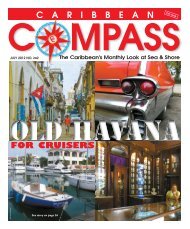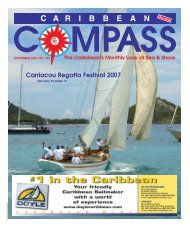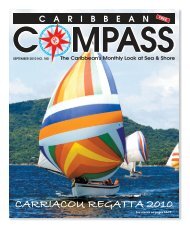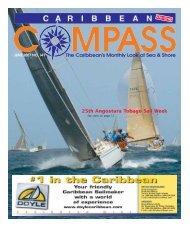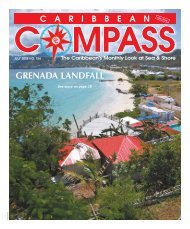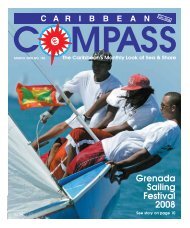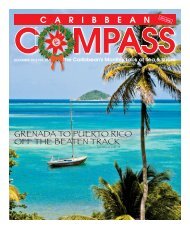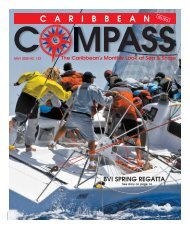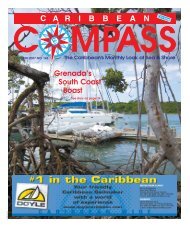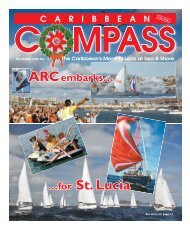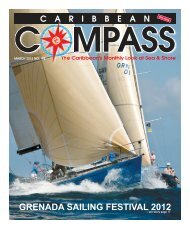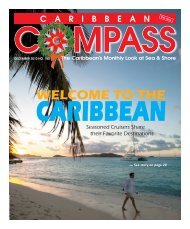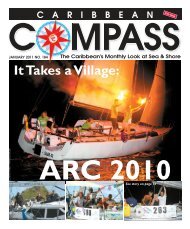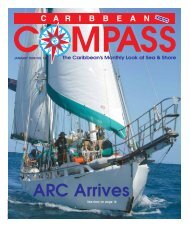do where do you want you want - Caribbean Compass
do where do you want you want - Caribbean Compass
do where do you want you want - Caribbean Compass
You also want an ePaper? Increase the reach of your titles
YUMPU automatically turns print PDFs into web optimized ePapers that Google loves.
DECEMBER 2011 CARIBBEAN COMPASS PAGE 26<br />
Yacht at Rest, Mind at Ease<br />
Photo by Onne van der Wal<br />
Meditation on Marigot Bay:<br />
Sails, Snails and<br />
Other Tales<br />
by Sean Fuller<br />
A considerable amount of legend, lore, fact and fancy shrouds the historical background<br />
of Marigot Bay, St. Lucia. It’s such a perfectly concealed bay, so surprising<br />
when revealed, and so perfect in its proportions, halfway <strong>do</strong>wn St. Lucia’s west coast,<br />
that it has captured sailors’ imaginations for centuries.<br />
It is not hard to believe that in the days of the buccaneers, many a pirate, including<br />
the legendary Bartholomew Roberts, used it as a base for attacking treasureladen<br />
galleons homeward bound from the Spanish Main. Cruising guide author Don<br />
Street says, “When anchored in Marigot Bay, read Ramage and the Freebooters by<br />
Dudley Pope; part of this novel is set here.”<br />
In the early 18th century, before France colonized St. Lucia, the land around<br />
Marigot Bay consisted of a few smallholdings used for raising livestock. Red mangroves<br />
lined the perimeter of the inner lagoon and coconut palms covered most of<br />
the hillside at low elevations. Copra, the meat from the coconut, was extracted and<br />
used to feed the livestock or for making coconut oil, used for cooking and in soap<br />
and detergents. The small village of Marigot at the head of the valley was populated<br />
mainly by families of fishermen who worked the coastal waters in dugout canoes<br />
carved from the gommier tree.<br />
With French colonization in the 18th century came the planting of sugarcane,<br />
which was first introduced to St. Lucia in 1763. 0n the inner bay close to the mangroves<br />
are the remains of a sugar mill and part of a stone house once used as a<br />
cookery to extract the syrup. Below the ruins is a well which is still largely intact<br />
although now full of earth. Close by, there used to be a <strong>do</strong>ck built by the French but<br />
VOYAGES FROM THE CARIBBEAN<br />
November, 2011 - June, 2012<br />
TO THE MEDITERRANEAN DEPARTURE<br />
Martinique � Genoa 03/2012<br />
Martinique � Taranto 06/2012<br />
Martinique � Toulon 06/2012<br />
St. Thomas � Palma de Mallorca 04/2012<br />
St. Thomas � Port Everglades 04/2012<br />
TO THE EAST COAST USA<br />
Martinique � Port Everglades 12/2011<br />
St. Thomas � Newport 05/2012<br />
Nadine Massaly<br />
DYT Representative<br />
Le Marin, Martinique<br />
silt from the hillside has since buried all<br />
remains of it. It is thought that fairly large<br />
sailing vessels used to call into the bay to<br />
collect the sugar.<br />
Although St. Lucia was French, the British<br />
<strong>want</strong>ed it, and after a long series of battles<br />
eventually took possession. One notable<br />
exchange, the battle of Cul de Sac, took<br />
place in December 1778, when the British<br />
under Admiral Samuel Barrington with 12<br />
ships and more than 5,000 men, entered<br />
Grand Cul-de-Sac Bay, just a little over a<br />
mile north of Marigot, with the aim of recapturing<br />
the island from the French. It is said<br />
that Admiral Barrington later hid his fleet in<br />
Marigot Bay behind the palm-lined sand<br />
spit and covered the rigging with palm<br />
fronds. The French fleet sailed past unwittingly<br />
and was subsequently ambushed by<br />
the British.<br />
This scene has been reproduced in a huge<br />
mural painted by Barbara Byfield and commissioned<br />
by Walter Boudreau, the schooner<br />
skipper who built the first hotel here in<br />
the 1950s. Boudreau asked that his family<br />
and other Marigot residents be painted into<br />
the historical scene and the result is a<br />
somewhat amusing caricature of the distant<br />
and more recent past. The mural still can be<br />
seen in the Boudreau restaurant at Marigot<br />
Bay Hotel.<br />
In the mid-1800s sugarcane began its long<br />
decline as a cash crop in the <strong>Caribbean</strong> as it<br />
was gradually replaced by cheaper sugar<br />
beet, which could be grown in Europe.<br />
The Bay today. A modern resort development<br />
<strong>do</strong>minates the shoreline <strong>where</strong> pioneering<br />
yacht-charter skipper Walter Boudreau once<br />
had his base<br />
One of the largest lan<strong>do</strong>wners after 1900 was Alfred Littman, who bought the land<br />
called Marigot de Roseaux estate from Oscar Napoleon Long in 1923. The property<br />
consisted of approximately 210 acres on the north and east side of the bay. Littman<br />
was the grandson of a Garifuna (Black Carib) from St. Vincent and a veteran of World<br />
War One. He was brought up in Vieux Fort and took various jobs aboard ships. He<br />
used the land for rearing sheep, made some copra on the estate, planted palms and<br />
marked property boundaries with immortelle (African tulip) trees.<br />
Twice during World War Two, local fishermen reported a German submarine lying<br />
in Marigot Bay’s inner harbour. A destroyer can just squeeze through the narrow<br />
straits between the south side and the central sand spit. One can imagine it being<br />
an excellent hideout from the chaos else<strong>where</strong>!<br />
A notable figure in the ‘modern’ era of Marigot Bay was Walter Boudreau. Born in<br />
1918 in Nova Scotia, Canada, Boudreau began sailing as a <strong>you</strong>ng boy. After spending<br />
three weeks at a medical university, he decided the call of the sea was more<br />
inviting. He got his first job aboard Angelus, a square-rigged barquentine, and<br />
worked his way around the globe over the years. At the end of World War Two he<br />
bought his first boat, a former rumrunner, which he sailed from North America to<br />
the <strong>Caribbean</strong>.<br />
He first visited Marigot Bay around 1952 onboard his schooner Doubloon and the<br />
images of this beautiful bay remained indelibly etched on his mind for years to come.<br />
To Walter, Marigot had a magical aura. After cruising up and <strong>do</strong>wn the Windward<br />
and Leeward islands for years, taking charter guests on cruises, Walter and his wife,<br />
Terry, decided to settle in Marigot Bay with their <strong>you</strong>ng children.<br />
—Continued on next page<br />
DYT Martinique: Tel. +596 596 741 507<br />
E-mail: nadine@<strong>do</strong>ckwise-yt.com<br />
WWW.YACHT-TRANSPORT.COM • 1 888 SHIP DYT



